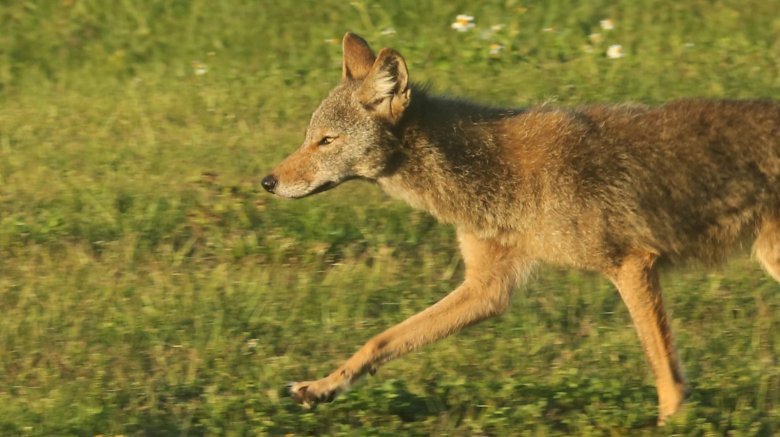This Is What You Should Do If You Encounter A Coyote
When Road Runner encountered Wile E. Coyote, he just dropped an anvil on the guy's head. Problem solved. In real life, though, coyotes aren't really trying to eat us and even if they were, an anvil would not be the answer. Anvils are never the answer.
So what should you do if you're out walking your dog on a peaceful summer evening and you suddenly encounter the Big, Bad Coyote? According to The Mercury News, it's important to remember that coyotes are wild animals, and should be treated with caution and respect. Most coyotes are wary of people. They may thrive in an urban environment, but that doesn't mean they want to move into your house or borrow your Netflix password. Most of the time, you can drive a coyote away just by standing your ground and making yourself appear threatening.
If you encounter a coyote while walking your dog, the first thing you should do is rein in your pet. If your dog is small, pick it up. If your dog is on the larger side, shorten the leash and keep the animal close to you. Stand tall and stare down the coyote. If that's not enough to make it move on, you can also shout or throw a rock. But avoid turning your back on it or worse, running away. A person who is running away might look like prey to a coyote, and unless you've got an anvil in your back pocket, you don't want to look like prey.
The Mercury News notes that your behavior should be somewhat different between February and July, when coyote moms have young pups in their dens. Like most large mammals, coyotes are protective of their young and aren't going to leave the area just because you're making noise. During this time of the year, you should maintain eye contact, but walk away from the coyote without turning your back on it.
Coyote attacks on human beings are rare, but it's wise to remember that they do happen occasionally, which means you can't afford to treat a coyote encounter like a trip to the zoo. In places where coyotes and humans frequently encounter each other, coyotes may be a lot less wary and could be bolder and more aggressive. In California, for example, DesertUSA says there were 48 attacks by coyotes on adults and children between 1998 and 2003.
Children are most at risk — in 1981 a coyote killed a 3-year-old girl who was playing alone in her front yard. But adults can be victims, too. In 2009, a 19-year-old folk singer named Taylor Mitchell was attacked and killed by coyotes while hiking alone in Highlands National Park in Nova Scotia. Scientists did a genetic analysis of the coyotes that attacked Mitchell and found that they were eastern coyotes, a hybrid species with genetic influence from gray wolves. Eastern coyotes are thought to be more likely to hunt in packs, and may be more dangerous than their western counterparts.
Most coyote encounters don't end in tragedy, but humans aren't the only species that could be potentially targeted. Pets are at much greater risk of becoming coyote victims, so the Humane Society recommends that people who live in or near coyote territory (and that includes many urban and suburban neighborhoods) keep their pets indoors, especially at night. Cats are easy prey for coyotes, and small breed dogs might also be targeted. To discourage coyotes around your home, make sure all pet food is kept inside and that you don't store trash outdoors. Call your local Department of Fish and Game if there is a nuisance coyote in your neighborhood — animals that attack pets, show no fear of humans, boldly approach people or menace people and animals are dangerous and should be reported to authorities.
You really don't need to spend too much time thinking about your local coyote neighbors, though. Humans who take the right precautions and who know what to do when they come face to face with Wile E. aren't going to have to worry about the fact that they share territory with our dogs' distant cousin. So don't let the presence of coyotes deter you from your daily walk, and rest assured you can safely leave the anvil at home.
